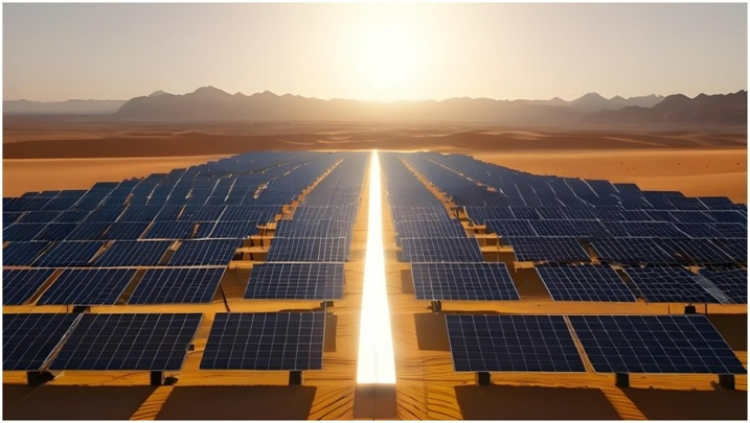‘These changes everything!’. ‘Scientists discover novel substances to boost solar panels performance’. ‘New solar material that breaks all records!’. Over the last few decades, these headlines or similar have been used to describe groundbreaking discoveries in solar energy that have continued to optimise the energy humans can tap from the sun. In this article, we will explore the journey so far, the current state of solar technology, and the future we can look forward to in the industry. Before that, let us explain why the world urgently needs solar energy.
The global energy crisis and the role of renewable energy

It’s no longer news that the world is undergoing an energy crisis. Population, economic growth, and unprecedented technological expansion have brought energy demands to an all-time peak globally. Unsurprisingly, fossil fuel reserves are quickly depleted, and rising geopolitical conflicts are making the need for a new and sustainable energy source necessary with all haste. This has led to volatile energy prices and heightened concerns about climate change due to greenhouse gas emissions.
Renewable energy comes to the rescue here, providing a sustainable solution. Natural elements such as the sun, wind, and water can now be leveraged to reduce human dependency on fossil fuels. By diversifying energy systems and lowering carbon footprints, renewables enhance energy security, promote affordability, and support global climate goals, such as achieving net-zero emissions.
The seventh tenet of the Sustainable Development Goals, which is focused on providing affordable, reliable, sustainable, and modern energy for all by 2030, heavily relies on solar energy. With solar energy, remote areas can have off-grid solar solutions, some of them for the first time. It is a better option than fossil fuels as it reduces greenhouse gas emissions, reducing the debilitating climate change. The solar industry creates new job opportunities as new skill sets in manufacturing, installing, and maintaining solar equipment are highly sought after. Over the past two decades, the world has achieved remarkable milestones in embracing solar. Here is an overview of some of the most notable metrics.

Current PV market and technology
1. Market size and growth:
The global solar PV market was valued at USD 289.6 billion in 2023. The major players include China, the U.S., and Europe, which lead the market with over 1 TW capacity. This unprecedented rise is driven by factors such as decreasing costs of PV systems, governmental subsidies, and increased focus on achieving net-zero emissions.
2. Dominant PV technologies:
In the earlier period, when crystalline Silicon was first considered for solar energy, it was deemed energy-intensive and costly. However, over the past decades, spectacular improvements along the manufacturing chain have made crystalline silicon a low-cost source of electricity that can no longer be ignored. In 2020 alone, over 125 GW of crystalline silicon modules have been installed, making up 95% of the overall photovoltaic (PV) market. Over 700 GW has been installed cumulatively, with strong indications that crystalline silicon could become one of the most important components of world solar electricity by 2040–2050. There are two major types used in photovoltaics: monocrystalline and polycrystalline. Monocrystalline Silicon has a higher efficiency of about 20-22%. However, it’s more expensive, while polycrystalline silicon is cheaper but less efficient.
Other popular elements in photovoltaic cells include thin-film technologies such as Cadmium telluride (CdTe) and CIGS (Copper Indium Gallium Selenide). These have an even lesser efficiency of about 15-17%, but they have the advantage of better performance in low sunlight or high-temperature conditions.
3. Cost trends
One of the most revolutionary changes in the solar energy industry over the last few decades has been the massive drop in the cost of clean energy. The levelized cost of solar electricity has dropped by over 80% since 2010, and the cost of batteries has fallen by more than 90%. For utility-scale solar projects, the current average price of PV systems is about $0.20–$0.30/Watt.
Advancements in solar cell efficiency are a key driver behind the consistent decline in solar energy costs. This aligns with Wright’s Law, which states that as the cumulative production of technology increases, its cost decreases predictably over time.
Current challenges in the PV market
Raw material supply chains: The COVID-19 pandemic has exposed fragility within the global supply chain, affecting the solar sector. The global shutdowns created massive shortages in raw materials such as crystalline silicon, silver, and aluminium used in manufacturing solar panels. As a result, after the pandemic, many companies are reevaluating their supply chain strategies to accommodate more diversification and local production and minimise possible future supply chain disruptions.
Grid Integration Issues: Another nagging challenge with deploying solar energy is integrating solar power into existing electrical grids. This poses a significant issue because of the variability of solar output. Sometimes, the energy output is too much, and at other times, too little.
Land Availability: Many factors come into play when siting land for solar farms. The two most difficult to contend with are proximity to the grid and large acreage, especially in urban regions. Utility-scale solar farms often compete with agriculture and real estate for land. Many agricultural areas struggle to allocate land between solar panels and crops. This makes the selection process controversial, and differences based on the land may also affect local economies and ecosystems.
Additionally, large blocks of land may be too expensive to secure in areas with high-cost real estate, making installing solar arrays unfeasible. This financial hurdle may make it harder for developers to develop projects in less-than-ideal ways, forcing geography, like areas with low sunlight or far from grid connections.
However, despite all these hurdles, the solar energy industry continues to grow and improve alongside other renewables, attaining breakthroughs that make solar panels more efficient.
Breakthroughs in solar panel efficiency
In 1883, Charles Fritts created the first solar cell, which produced only a tiny amount of electricity with about 2% efficiency. Since then, solar technology has undergone a series of breakthroughs that have led to what we know today. Today, most silicon solar cells can boast around 22% efficiency. Modern advancements in solar technology are bringing the number up. Let’s consider some of such advancements.
Multi-junction solar cells and tandem cells
Multi-junction solar cells can absorb different wavelengths of incoming sunlight using various layers, making them more efficient at converting sunlight into electricity than single-junction cells.
Tandem cells stack two or more layers to maximise photon absorption. These designs achieve higher efficiency by capturing more sunlight, surpassing the theoretical limits of single-junction cells. Research shows tandem cells can exceed 40% efficiency under optimal conditions.
While they have the potential to be many times more efficient than traditional solar cells, high production costs currently make multi-junction cells unfeasible. However, ongoing research and development might proffer a solution.
Passivated Emitter and Rear Contact (PERC) solar cells
Another advanced solar cell that is becoming popular is the Passivated Emitter and Rear Contact solar cell, also known as PERC solar cells. PERC solar cells are an improved variant of conventional cells that enable them to produce 6-12% more energy than traditional solar panels. How does it work? PERC solar cells have an extra layer within the cell’s backside. This allows some sun to reflect into the solar cell, providing another pathway to generate energy.
PERC solar cells are also manufactured using the same equipment but are efficient. With the more efficient cells, producing the same amount of electricity will require fewer panels than a conventional panel.
However, this modification comes at a price. It creates a new vulnerability within the solar panels. Most PERC solar panels have metal strips running through them. These strips are more prone to cracking or disconnecting; once this happens, they are more likely to lose the ability to generate electricity.
Innovations in surface coatings are another modification in solar cells that improves efficiency by enhancing energy absorption and minimising reflection losses. Anti-reflective coatings (ARCs) reduce light reflection on solar panels, ensuring more sunlight enters the cells. Nanostructured coatings, like plasmonic materials or textured surfaces, trap light through scattering and diffraction. Hydrophobic and self-cleaning coatings improve performance by keeping panels dirt-free.
Researchers have recently discovered a more efficient material than silicon: perovskites.
Perovskite solar cells
Perovskites are the latest promising breakthrough technology for solar panels. They are also a family of crystalline compounds like silicon but with more advantages. They can respond to different colours in the solar spectrum, meaning that when combined with another material, such as silicon, they can deliver more power from the same device.
Additionally, perovskites are easier to manufacture, less expensive, and more flexible. These added advantages are making perovskites popular in the solar industry. They are fast becoming the focus of increasing research and investment, with organizations around the globe, including in Germany, Saudi Arabia, and China, working to find variations that present the best efficiency, highest durability, and lowest cost.
Organic Photovoltaics (OPV)
OPVs are another futuristic technology that researchers believe has the potential to provide electricity at a lower cost than traditional silicon-based solar technologies. This revolutionary solar technology has a lightweight, flexible design and high urban integration potential. Organic photovoltaics are made from carbon-based materials. One of their best selling points is that they can be printed on thin, flexible substrates, enabling their use on curved surfaces, windows, and building facades that are commonplace in urban settings. Their adaptability makes them ideal for urban areas where traditional solar panels may not fit. Although their efficiency is lower than silicon-based panels, ongoing advancements in materials and tandem cell technology promise higher performance and broader adoption.
The future of solar technologies
Cutting-edge technologies are rapidly reshaping what can be attained in the solar energy industry. Some are not entirely new but rather a refined improvement of old ideas.
Bifacial solar panels
As the name suggests, a bifacial solar panel is a module with PV cells on both the front and back sides, designed to capture sunlight from both sides. Unlike traditional solar panels that only collect light from the front, bifacial panels harness energy from their front and back surfaces. The idea of bifacial solar panels had initially emerged in the 1960s. However, it was not widely accepted at the time. In the early 2000s, bifacial technology began to re-emerge, becoming more widely accepted and promising for the future. By harnessing reflected light from surrounding surfaces, bifacial panels can boost energy production by up to 30% compared to their monofacial counterparts. Bifacial panels are particularly effective in environments with highly reflective surfaces, such as snow, sand, or light-coloured roofs. They can be installed vertically, horizontally, or at an angle, making them adaptable to diverse architectural designs and geographical locations.
While bifacial solar panels have the advantages of increased yield and long-term economic benefits, they also have some downsides. Bifacial solar panels are more expensive than conventional models. This increased upfront investment can be a deterrent for some buyers or developers, particularly in residential scenarios.
Floating solar farms

Floating solar panels are another technology energy companies are utilising, and they have a promising future. The technology enables energy companies to expand solar power without taking up more land, especially in regions with a scarcity of land. In 2021, the installed capacity worldwide was significantly above 2GW and has increased since then, according to the Fraunhofer Institute for Solar Energy Systems (ISE). Solar modules that are mounted on floating platforms tend to perform better. Their proximity to water could support the cooling of solar cells, thus enabling them to work efficiently even in hot weather conditions.
To prevent the modules from drifting off, for example, in strong winds, they can be anchored to concrete blocks at the bottom of the water body. Then, cables will be laid to bring the electricity generated onshore and feed it into the power plant grid.
Quantum dot solar cells
Quantum dot solar cells are another futuristic photovoltaic technology. They use quantum dots, which are nanometer-sized semiconductor particles with tunable optical properties. These advanced materials have improved light absorption and energy conversion efficiency that will surely surpass traditional solar panels.
Quantum dot solar cells absorb a broader range of the solar spectrum. They can be manipulated to target specific wavelengths of sunlight, thereby optimising energy harvesting and potentially surpassing the efficiency limit of conventional solar cells. This ability stems from quantum confinement effects, which allow precise control over the dots’ electronic and optical properties.
In addition to their efficiency potential, QDSCs are manufactured using low-cost, solution-based processes such as spin coating or inkjet printing. These methods reduce production costs and enable the creation of lightweight, flexible solar panels that can be applied to unconventional surfaces, such as windows, fabrics, or portable devices. Thus, they are one of the most promising solar technologies that will become widely accepted in the near future.
Another promising advantage of quantum dot solar cells is their ability to perform in low-light conditions. Unlike traditional silicon panels that depend heavily on direct sunlight, quantum dots can capture diffused light, enabling consistent energy generation even on cloudy days or in shaded areas. This adaptability could significantly improve the reliability and scalability of solar energy in diverse environments.
Ongoing research focuses on enhancing the stability and scalability of quantum dot technology, particularly by addressing issues like material degradation and toxicity in lead-based quantum dots. Emerging solutions, such as perovskite-quantum dot hybrids and non-toxic alternatives like silicon or copper-based quantum dots, are paving the way for safer and more efficient devices.
Incorporating quantum dot solar cells into future photovoltaic systems could transform how solar energy is harnessed, making it more accessible, versatile, and efficient.
Predictions for Solar Panel Efficiency and Costs by 2030
Advancements in photovoltaic technology are set to boost solar panel efficiency beyond 30% by 2030, with perovskite-silicon tandem cells leading the way. Manufacturing innovations and economies of scale could lower costs, making solar energy more accessible and cost-effective worldwide. Building iIntegratingaics and transparent solar panels are transforming into energy hubs. These solutions integrate solar cells into windows and rooftops, blending sustainability with modern design. Solar energy is critical to achieving net-zero emissions by 2050. Its scalability supports decentralised energy systems, reduces reliance on fossil fuels, and accelerates universal energy access, aligning with SDG 7 goals.
What role do we play?
Building integrated solar cells and transparent solar panels is imperative to drive investing research and development and adopt cutting-edge technologies like perovskite cells. These drive the global energy transition innovations that promise to enhance efficiency, lower costs, and incorporate energy seamlessly into our lives.
By prioritizing these advancements, we can accelerate progress toward net-zero emissions and ensure sustainable energy for all. We can commit to supporting solar innovation today for a greener future.
About the Author

Daniel Maduagwu, PMP, is a seasoned executive with over 20 years of leadership experience in renewable energy, electrical power, and telecommunications across Sub-Saharan Africa. As the Founder and CEO of 3KM Energy Systems, he has successfully spearheaded transformative energy transition projects for the Nigerian government and pioneered innovative strategies to accelerate renewable energy adoption in the commercial and industrial sectors. Known for his strategic vision, team-building expertise, and commitment to customer satisfaction, Daniel is passionate about driving impactful change toward a more sustainable future. His career is defined by a consistent track record of delivering results, managing high-performing teams, and leveraging technology to foster business growth and innovation.
Connect with Daniel Maduagwu on LinkedIn.
Find 3KM Energy Systems on LinkedIn or visit https://3kmenergy.com/
Also Read :-
Trump Avoids Imposing Tariffs on China on Cellphones and Other Gadgets
Ahmed Alqadeeb: Leadership and Business Growth in Saudi Arabia
Abdulrahman Alsheail: Leading with People, Shaping Institutions































































